Business Decision Making Report - Data Analysis for Business Decisions
VerifiedAdded on 2020/02/17
|22
|4731
|147
Report
AI Summary
This report presents a comprehensive analysis of business decision-making using statistical methods. It begins with a research plan for a mobile phone, outlining objectives, methodology, and a budget. The report details the survey methodology, sampling frame, and a questionnaire used to collect data. Descriptive statistics, including mean, median, and mode, are calculated and interpreted to provide insights into customer spending patterns. Measures of dispersion, such as standard deviation, are also computed. Data is presented graphically using charts and trend lines to assess future business information. A network diagram and project evaluation methods, like NPV and IRR, are used to evaluate proposals, and the report concludes with a formal business report summarizing the findings and recommendations.
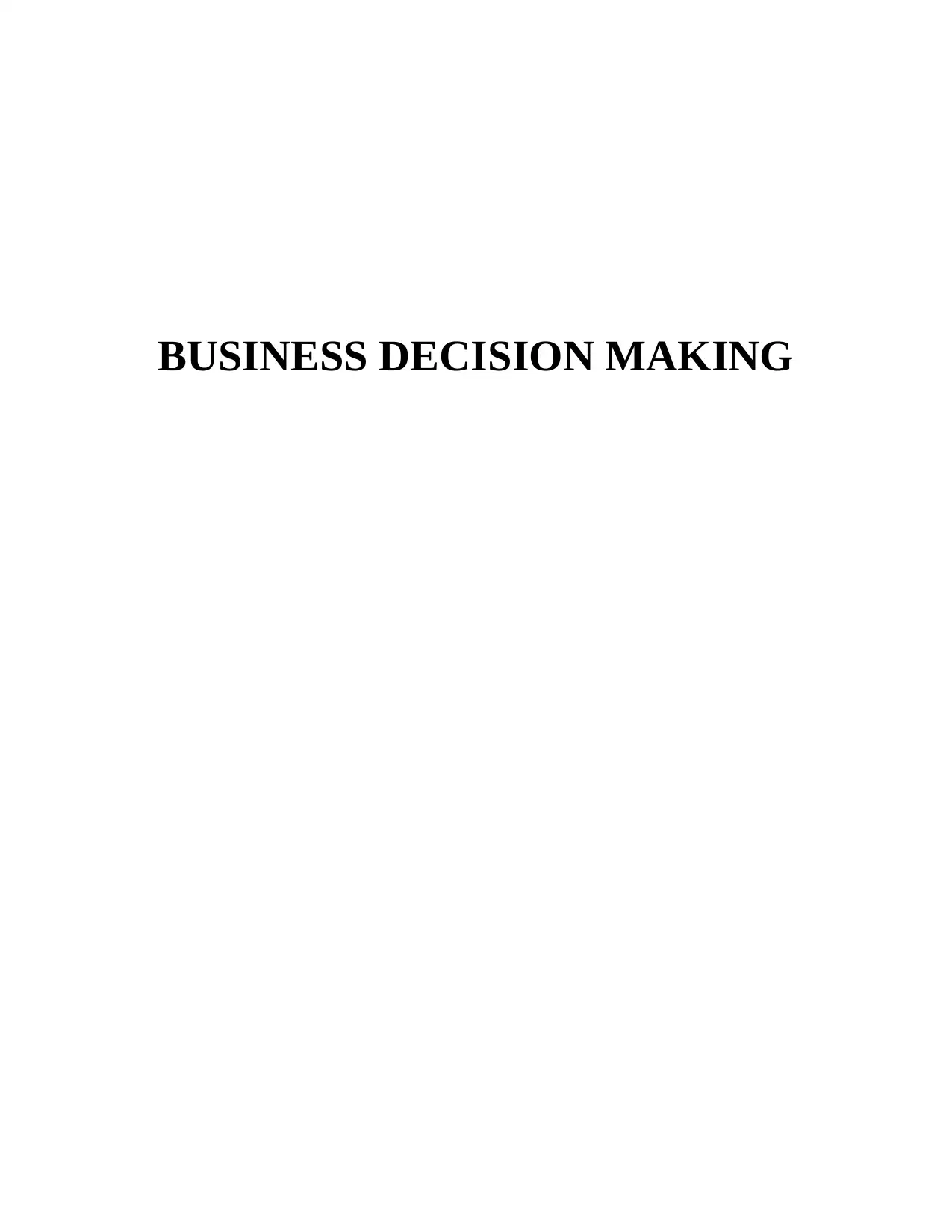
BUSINESS DECISION MAKING
Paraphrase This Document
Need a fresh take? Get an instant paraphrase of this document with our AI Paraphraser
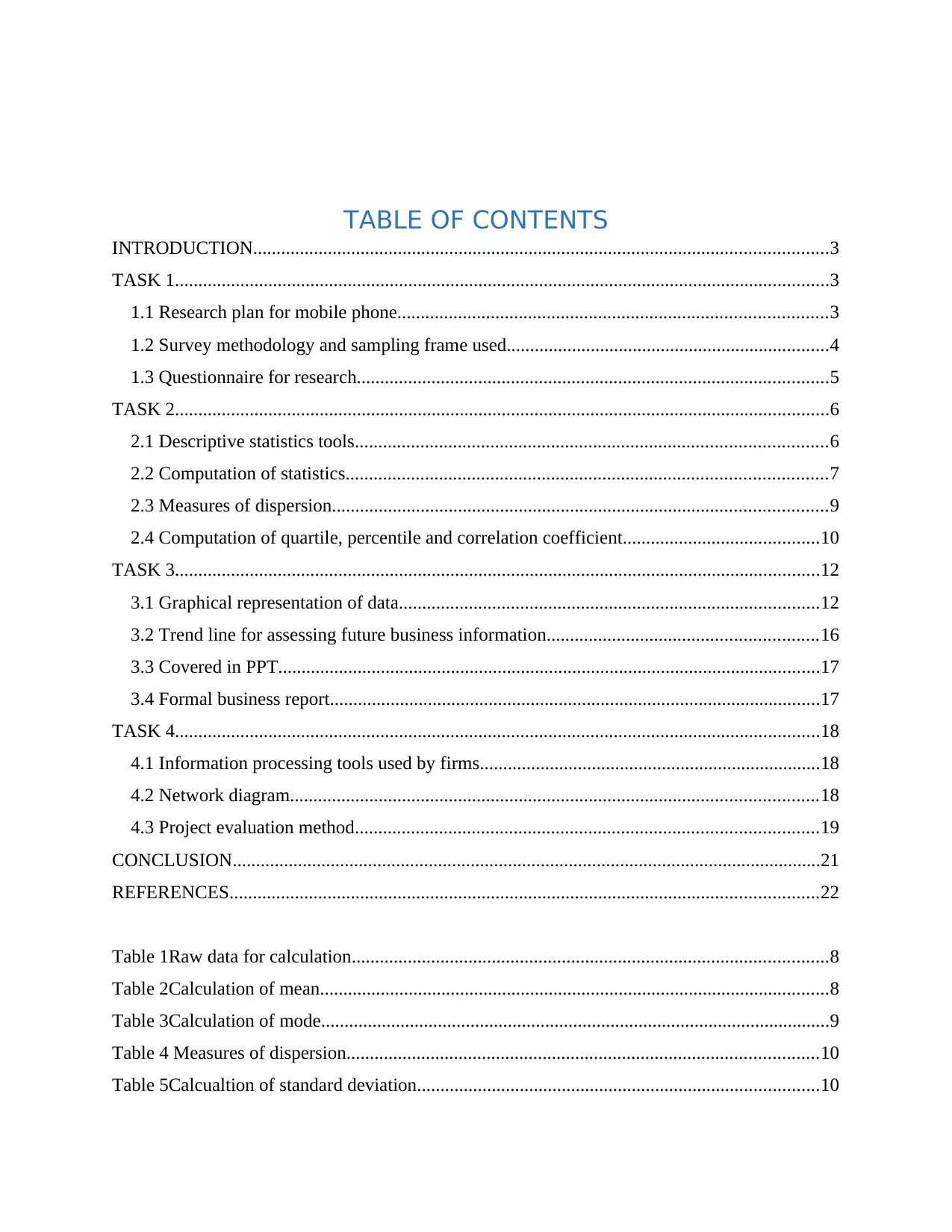
TABLE OF CONTENTS
INTRODUCTION...........................................................................................................................3
TASK 1............................................................................................................................................3
1.1 Research plan for mobile phone............................................................................................3
1.2 Survey methodology and sampling frame used.....................................................................4
1.3 Questionnaire for research.....................................................................................................5
TASK 2............................................................................................................................................6
2.1 Descriptive statistics tools.....................................................................................................6
2.2 Computation of statistics.......................................................................................................7
2.3 Measures of dispersion..........................................................................................................9
2.4 Computation of quartile, percentile and correlation coefficient..........................................10
TASK 3..........................................................................................................................................12
3.1 Graphical representation of data..........................................................................................12
3.2 Trend line for assessing future business information..........................................................16
3.3 Covered in PPT....................................................................................................................17
3.4 Formal business report.........................................................................................................17
TASK 4..........................................................................................................................................18
4.1 Information processing tools used by firms.........................................................................18
4.2 Network diagram.................................................................................................................18
4.3 Project evaluation method...................................................................................................19
CONCLUSION..............................................................................................................................21
REFERENCES..............................................................................................................................22
Table 1Raw data for calculation......................................................................................................8
Table 2Calculation of mean.............................................................................................................8
Table 3Calculation of mode.............................................................................................................9
Table 4 Measures of dispersion.....................................................................................................10
Table 5Calcualtion of standard deviation......................................................................................10
INTRODUCTION...........................................................................................................................3
TASK 1............................................................................................................................................3
1.1 Research plan for mobile phone............................................................................................3
1.2 Survey methodology and sampling frame used.....................................................................4
1.3 Questionnaire for research.....................................................................................................5
TASK 2............................................................................................................................................6
2.1 Descriptive statistics tools.....................................................................................................6
2.2 Computation of statistics.......................................................................................................7
2.3 Measures of dispersion..........................................................................................................9
2.4 Computation of quartile, percentile and correlation coefficient..........................................10
TASK 3..........................................................................................................................................12
3.1 Graphical representation of data..........................................................................................12
3.2 Trend line for assessing future business information..........................................................16
3.3 Covered in PPT....................................................................................................................17
3.4 Formal business report.........................................................................................................17
TASK 4..........................................................................................................................................18
4.1 Information processing tools used by firms.........................................................................18
4.2 Network diagram.................................................................................................................18
4.3 Project evaluation method...................................................................................................19
CONCLUSION..............................................................................................................................21
REFERENCES..............................................................................................................................22
Table 1Raw data for calculation......................................................................................................8
Table 2Calculation of mean.............................................................................................................8
Table 3Calculation of mode.............................................................................................................9
Table 4 Measures of dispersion.....................................................................................................10
Table 5Calcualtion of standard deviation......................................................................................10
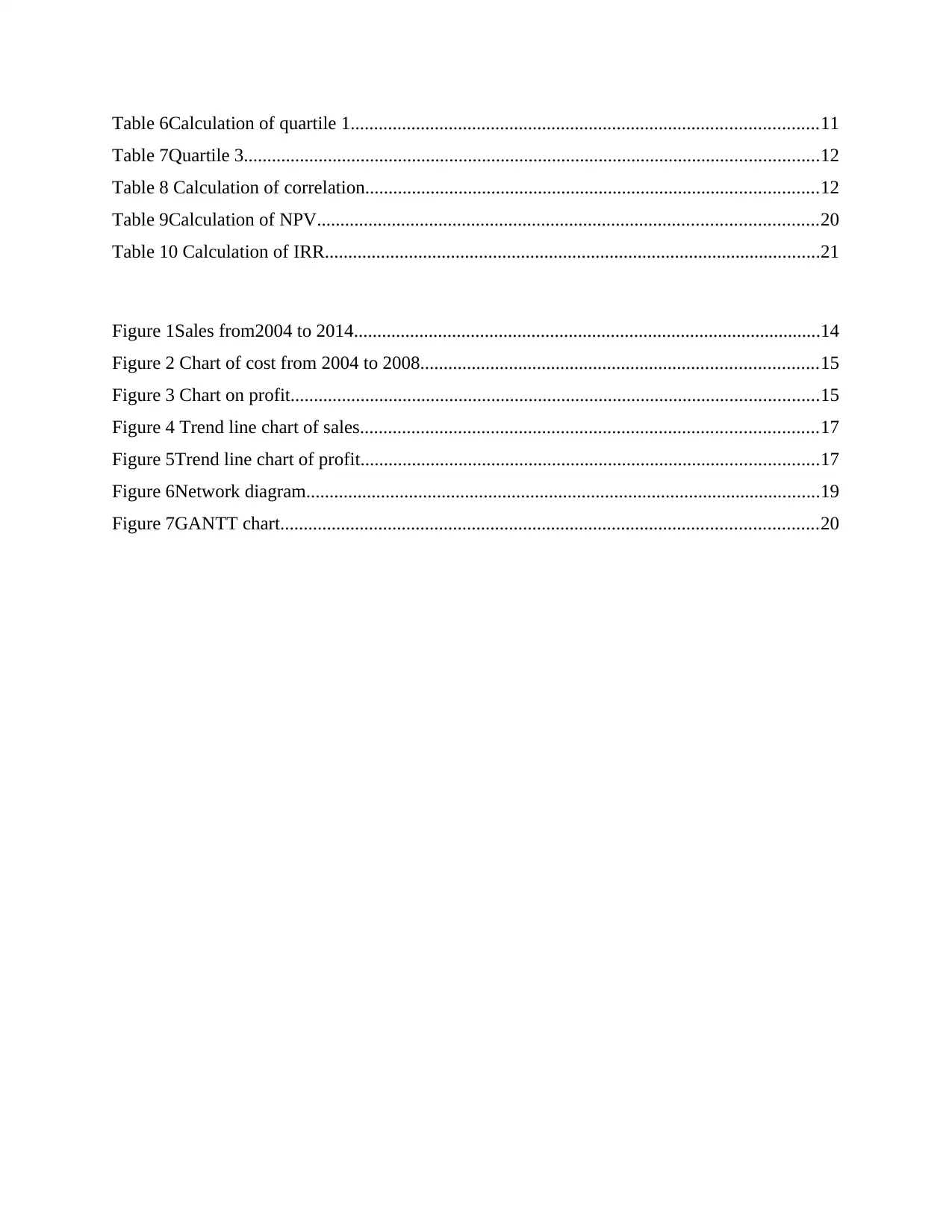
Table 6Calculation of quartile 1....................................................................................................11
Table 7Quartile 3...........................................................................................................................12
Table 8 Calculation of correlation.................................................................................................12
Table 9Calculation of NPV...........................................................................................................20
Table 10 Calculation of IRR..........................................................................................................21
Figure 1Sales from2004 to 2014....................................................................................................14
Figure 2 Chart of cost from 2004 to 2008.....................................................................................15
Figure 3 Chart on profit.................................................................................................................15
Figure 4 Trend line chart of sales..................................................................................................17
Figure 5Trend line chart of profit..................................................................................................17
Figure 6Network diagram..............................................................................................................19
Figure 7GANTT chart...................................................................................................................20
Table 7Quartile 3...........................................................................................................................12
Table 8 Calculation of correlation.................................................................................................12
Table 9Calculation of NPV...........................................................................................................20
Table 10 Calculation of IRR..........................................................................................................21
Figure 1Sales from2004 to 2014....................................................................................................14
Figure 2 Chart of cost from 2004 to 2008.....................................................................................15
Figure 3 Chart on profit.................................................................................................................15
Figure 4 Trend line chart of sales..................................................................................................17
Figure 5Trend line chart of profit..................................................................................................17
Figure 6Network diagram..............................................................................................................19
Figure 7GANTT chart...................................................................................................................20
⊘ This is a preview!⊘
Do you want full access?
Subscribe today to unlock all pages.

Trusted by 1+ million students worldwide
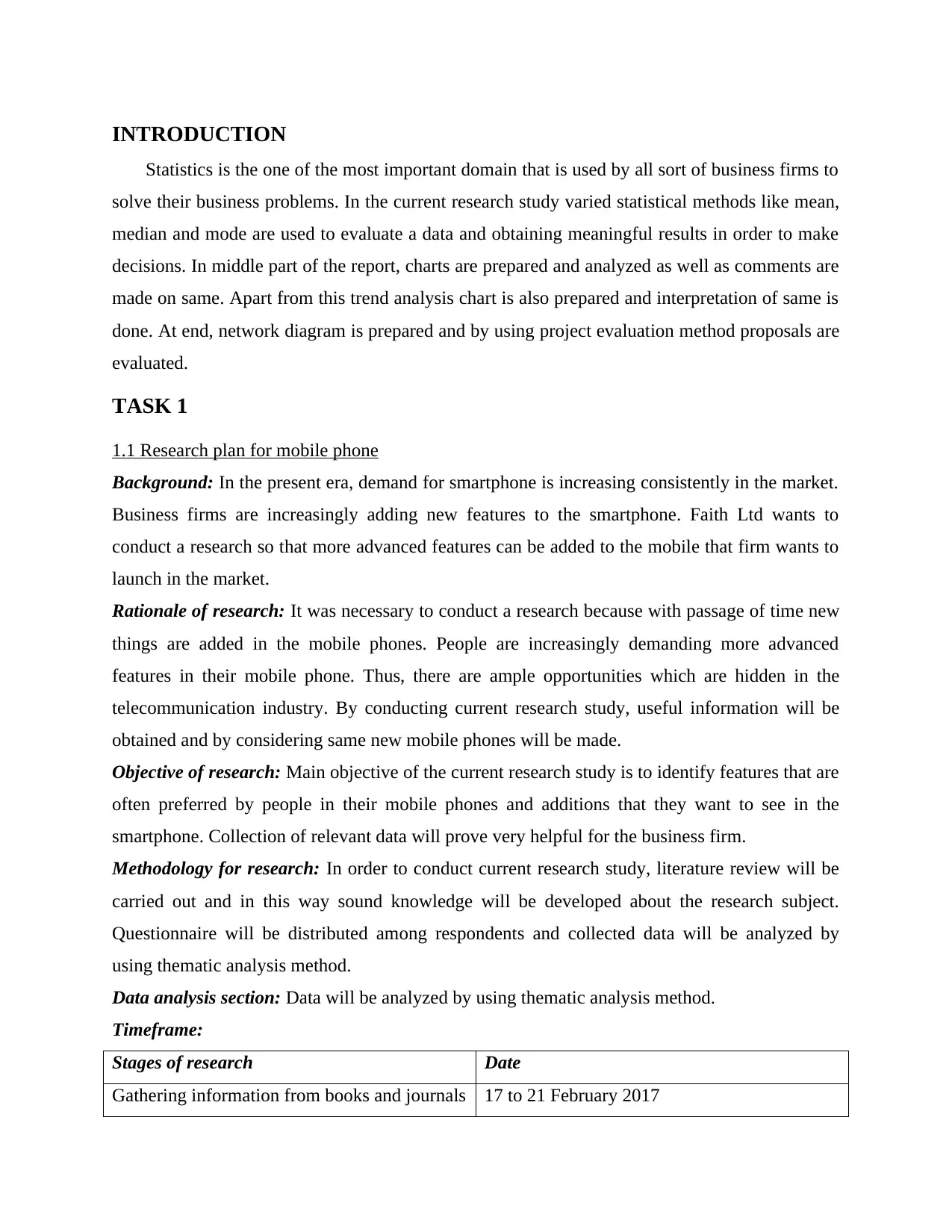
INTRODUCTION
Statistics is the one of the most important domain that is used by all sort of business firms to
solve their business problems. In the current research study varied statistical methods like mean,
median and mode are used to evaluate a data and obtaining meaningful results in order to make
decisions. In middle part of the report, charts are prepared and analyzed as well as comments are
made on same. Apart from this trend analysis chart is also prepared and interpretation of same is
done. At end, network diagram is prepared and by using project evaluation method proposals are
evaluated.
TASK 1
1.1 Research plan for mobile phone
Background: In the present era, demand for smartphone is increasing consistently in the market.
Business firms are increasingly adding new features to the smartphone. Faith Ltd wants to
conduct a research so that more advanced features can be added to the mobile that firm wants to
launch in the market.
Rationale of research: It was necessary to conduct a research because with passage of time new
things are added in the mobile phones. People are increasingly demanding more advanced
features in their mobile phone. Thus, there are ample opportunities which are hidden in the
telecommunication industry. By conducting current research study, useful information will be
obtained and by considering same new mobile phones will be made.
Objective of research: Main objective of the current research study is to identify features that are
often preferred by people in their mobile phones and additions that they want to see in the
smartphone. Collection of relevant data will prove very helpful for the business firm.
Methodology for research: In order to conduct current research study, literature review will be
carried out and in this way sound knowledge will be developed about the research subject.
Questionnaire will be distributed among respondents and collected data will be analyzed by
using thematic analysis method.
Data analysis section: Data will be analyzed by using thematic analysis method.
Timeframe:
Stages of research Date
Gathering information from books and journals 17 to 21 February 2017
Statistics is the one of the most important domain that is used by all sort of business firms to
solve their business problems. In the current research study varied statistical methods like mean,
median and mode are used to evaluate a data and obtaining meaningful results in order to make
decisions. In middle part of the report, charts are prepared and analyzed as well as comments are
made on same. Apart from this trend analysis chart is also prepared and interpretation of same is
done. At end, network diagram is prepared and by using project evaluation method proposals are
evaluated.
TASK 1
1.1 Research plan for mobile phone
Background: In the present era, demand for smartphone is increasing consistently in the market.
Business firms are increasingly adding new features to the smartphone. Faith Ltd wants to
conduct a research so that more advanced features can be added to the mobile that firm wants to
launch in the market.
Rationale of research: It was necessary to conduct a research because with passage of time new
things are added in the mobile phones. People are increasingly demanding more advanced
features in their mobile phone. Thus, there are ample opportunities which are hidden in the
telecommunication industry. By conducting current research study, useful information will be
obtained and by considering same new mobile phones will be made.
Objective of research: Main objective of the current research study is to identify features that are
often preferred by people in their mobile phones and additions that they want to see in the
smartphone. Collection of relevant data will prove very helpful for the business firm.
Methodology for research: In order to conduct current research study, literature review will be
carried out and in this way sound knowledge will be developed about the research subject.
Questionnaire will be distributed among respondents and collected data will be analyzed by
using thematic analysis method.
Data analysis section: Data will be analyzed by using thematic analysis method.
Timeframe:
Stages of research Date
Gathering information from books and journals 17 to 21 February 2017
Paraphrase This Document
Need a fresh take? Get an instant paraphrase of this document with our AI Paraphraser
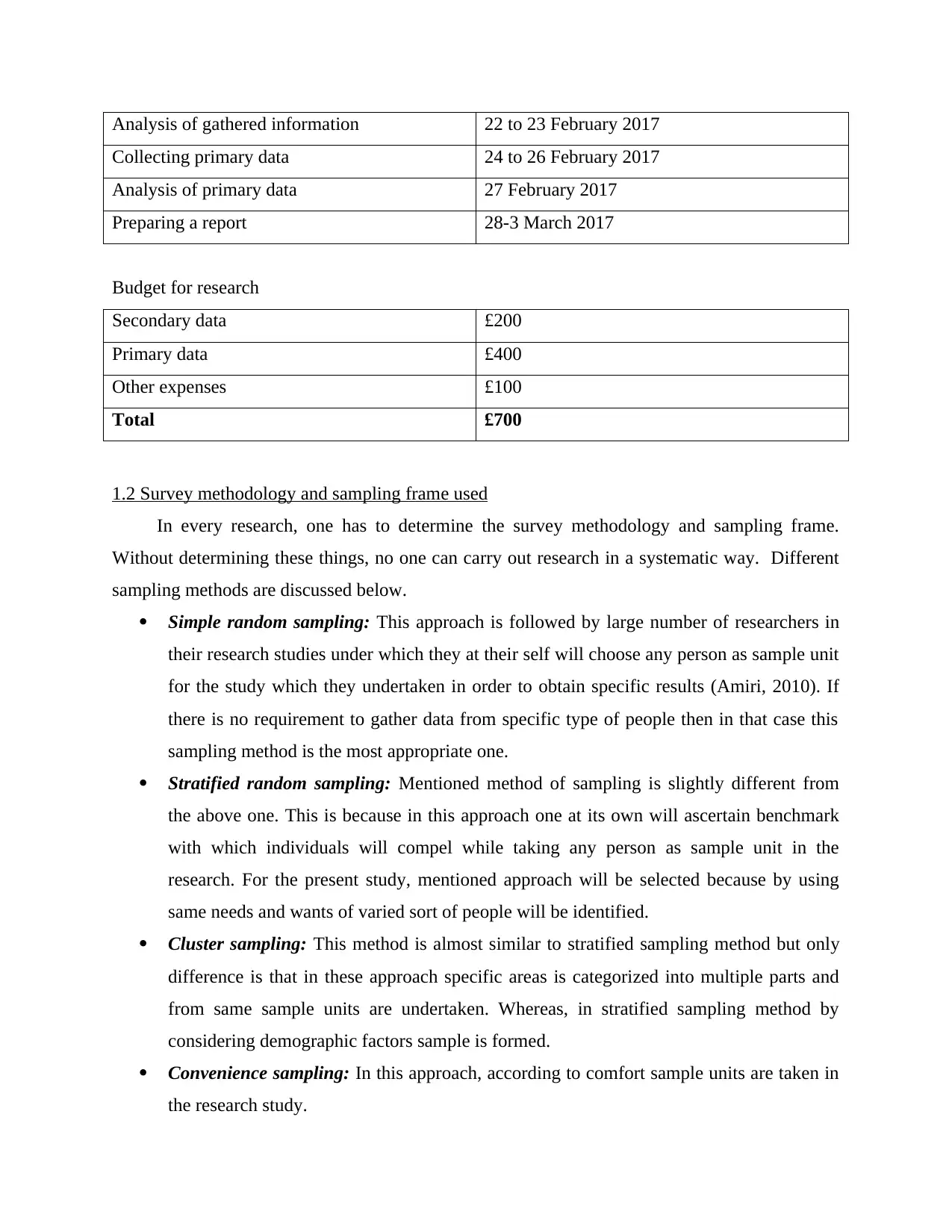
Analysis of gathered information 22 to 23 February 2017
Collecting primary data 24 to 26 February 2017
Analysis of primary data 27 February 2017
Preparing a report 28-3 March 2017
Budget for research
Secondary data £200
Primary data £400
Other expenses £100
Total £700
1.2 Survey methodology and sampling frame used
In every research, one has to determine the survey methodology and sampling frame.
Without determining these things, no one can carry out research in a systematic way. Different
sampling methods are discussed below.
Simple random sampling: This approach is followed by large number of researchers in
their research studies under which they at their self will choose any person as sample unit
for the study which they undertaken in order to obtain specific results (Amiri, 2010). If
there is no requirement to gather data from specific type of people then in that case this
sampling method is the most appropriate one.
Stratified random sampling: Mentioned method of sampling is slightly different from
the above one. This is because in this approach one at its own will ascertain benchmark
with which individuals will compel while taking any person as sample unit in the
research. For the present study, mentioned approach will be selected because by using
same needs and wants of varied sort of people will be identified.
Cluster sampling: This method is almost similar to stratified sampling method but only
difference is that in these approach specific areas is categorized into multiple parts and
from same sample units are undertaken. Whereas, in stratified sampling method by
considering demographic factors sample is formed.
Convenience sampling: In this approach, according to comfort sample units are taken in
the research study.
Collecting primary data 24 to 26 February 2017
Analysis of primary data 27 February 2017
Preparing a report 28-3 March 2017
Budget for research
Secondary data £200
Primary data £400
Other expenses £100
Total £700
1.2 Survey methodology and sampling frame used
In every research, one has to determine the survey methodology and sampling frame.
Without determining these things, no one can carry out research in a systematic way. Different
sampling methods are discussed below.
Simple random sampling: This approach is followed by large number of researchers in
their research studies under which they at their self will choose any person as sample unit
for the study which they undertaken in order to obtain specific results (Amiri, 2010). If
there is no requirement to gather data from specific type of people then in that case this
sampling method is the most appropriate one.
Stratified random sampling: Mentioned method of sampling is slightly different from
the above one. This is because in this approach one at its own will ascertain benchmark
with which individuals will compel while taking any person as sample unit in the
research. For the present study, mentioned approach will be selected because by using
same needs and wants of varied sort of people will be identified.
Cluster sampling: This method is almost similar to stratified sampling method but only
difference is that in these approach specific areas is categorized into multiple parts and
from same sample units are undertaken. Whereas, in stratified sampling method by
considering demographic factors sample is formed.
Convenience sampling: In this approach, according to comfort sample units are taken in
the research study.
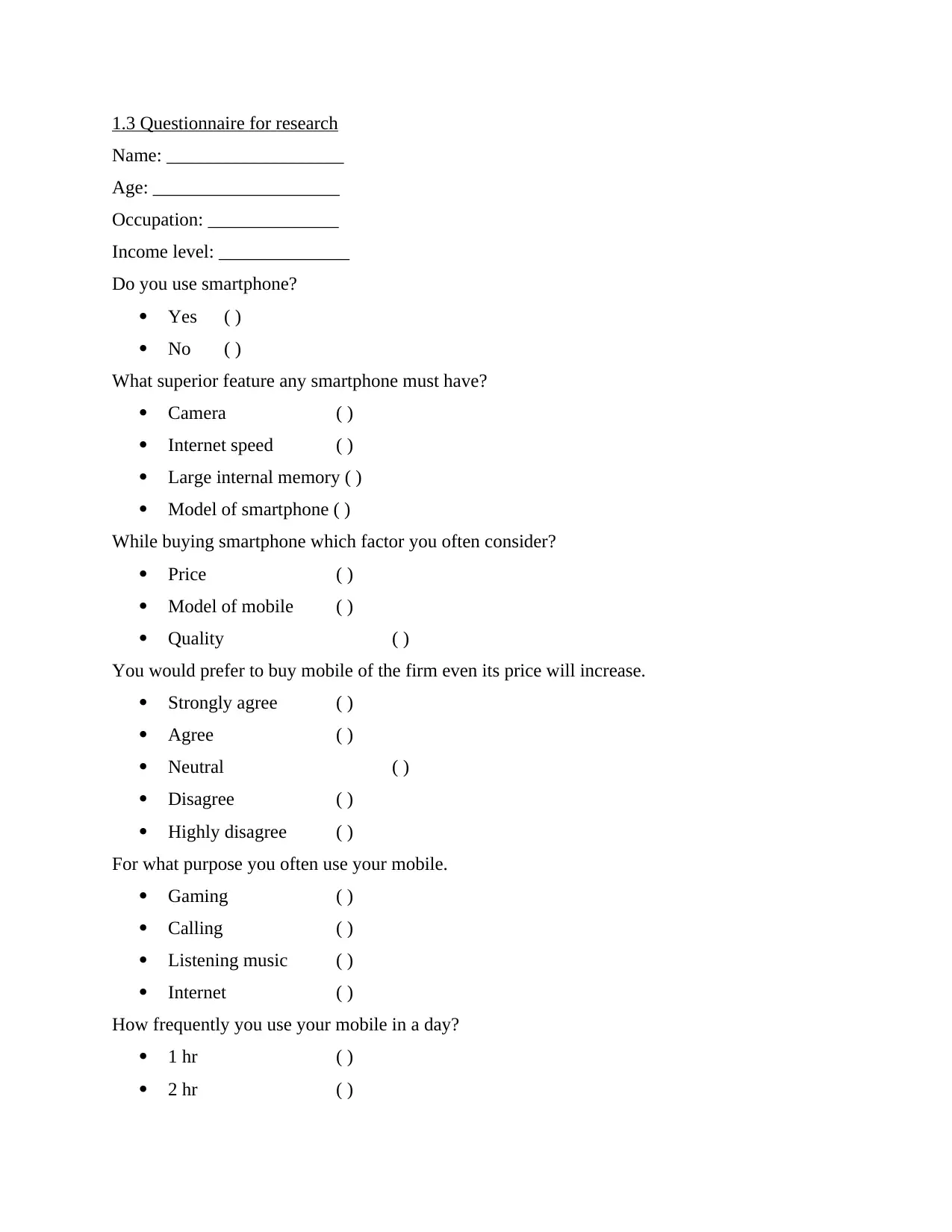
1.3 Questionnaire for research
Name: ___________________
Age: ____________________
Occupation: ______________
Income level: ______________
Do you use smartphone?
Yes ( )
No ( )
What superior feature any smartphone must have?
Camera ( )
Internet speed ( )
Large internal memory ( )
Model of smartphone ( )
While buying smartphone which factor you often consider?
Price ( )
Model of mobile ( )
Quality ( )
You would prefer to buy mobile of the firm even its price will increase.
Strongly agree ( )
Agree ( )
Neutral ( )
Disagree ( )
Highly disagree ( )
For what purpose you often use your mobile.
Gaming ( )
Calling ( )
Listening music ( )
Internet ( )
How frequently you use your mobile in a day?
1 hr ( )
2 hr ( )
Name: ___________________
Age: ____________________
Occupation: ______________
Income level: ______________
Do you use smartphone?
Yes ( )
No ( )
What superior feature any smartphone must have?
Camera ( )
Internet speed ( )
Large internal memory ( )
Model of smartphone ( )
While buying smartphone which factor you often consider?
Price ( )
Model of mobile ( )
Quality ( )
You would prefer to buy mobile of the firm even its price will increase.
Strongly agree ( )
Agree ( )
Neutral ( )
Disagree ( )
Highly disagree ( )
For what purpose you often use your mobile.
Gaming ( )
Calling ( )
Listening music ( )
Internet ( )
How frequently you use your mobile in a day?
1 hr ( )
2 hr ( )
⊘ This is a preview!⊘
Do you want full access?
Subscribe today to unlock all pages.

Trusted by 1+ million students worldwide

3 hr ( )
More than 3 hr ( )
Your feedback
TASK 2
2.1 Descriptive statistics tools Mean: In the descriptive statistics, there are number of statistical tools that come in this
category. If we compared all these tools with each other then it will be identified that
mean is one of the most important statistical tools which available for the researchers.
This is because by using this tool, overall performance of the specific variable for certain
interval can be measured. Thus, to some extent anticipation about future performance of
variable can be made on the basis of average value which is related to the specific
variable (Brennan, 2013). Mean is usually used in all sorts of researches. Even one is
doing research by using advanced tools like regression and cluster analysis, for
developing broad understanding about the variable first of all mean value of relevant one
is computed and then advanced tools are applied on the given data set. It can be said that
mean is the statistical tool which is important for the business firms. Median: Mean give picture of overall performance of the variable but it does not give
information about performance of variable in different time periods within specific
interval. This limitation of the mean is removed by the median. Median is the statistical
tool that classified set of figures in to two parts that are equal in nature. Now,
performance of the variable in these two different parts can be evaluated and overall more
accurate view of specific variable can be obtained. Mode: Like mean, there are some missing points in median. Median is the tool which
split set of figures into two parts but it does not reveal specific trend that is repeating
back to back. Mode remove this limitation and help in identifying the trend that is
repeating itself number of time during specific time period. Thus, it can be said that mode
is one of the most important tool that is used by the researchers to analyze the data in a
better way (De Vos and et.al., 2011). This tool is most often used in the finance sector
where research analysts identify single trend which is occurring again and again in the
More than 3 hr ( )
Your feedback
TASK 2
2.1 Descriptive statistics tools Mean: In the descriptive statistics, there are number of statistical tools that come in this
category. If we compared all these tools with each other then it will be identified that
mean is one of the most important statistical tools which available for the researchers.
This is because by using this tool, overall performance of the specific variable for certain
interval can be measured. Thus, to some extent anticipation about future performance of
variable can be made on the basis of average value which is related to the specific
variable (Brennan, 2013). Mean is usually used in all sorts of researches. Even one is
doing research by using advanced tools like regression and cluster analysis, for
developing broad understanding about the variable first of all mean value of relevant one
is computed and then advanced tools are applied on the given data set. It can be said that
mean is the statistical tool which is important for the business firms. Median: Mean give picture of overall performance of the variable but it does not give
information about performance of variable in different time periods within specific
interval. This limitation of the mean is removed by the median. Median is the statistical
tool that classified set of figures in to two parts that are equal in nature. Now,
performance of the variable in these two different parts can be evaluated and overall more
accurate view of specific variable can be obtained. Mode: Like mean, there are some missing points in median. Median is the tool which
split set of figures into two parts but it does not reveal specific trend that is repeating
back to back. Mode remove this limitation and help in identifying the trend that is
repeating itself number of time during specific time period. Thus, it can be said that mode
is one of the most important tool that is used by the researchers to analyze the data in a
better way (De Vos and et.al., 2011). This tool is most often used in the finance sector
where research analysts identify single trend which is occurring again and again in the
Paraphrase This Document
Need a fresh take? Get an instant paraphrase of this document with our AI Paraphraser
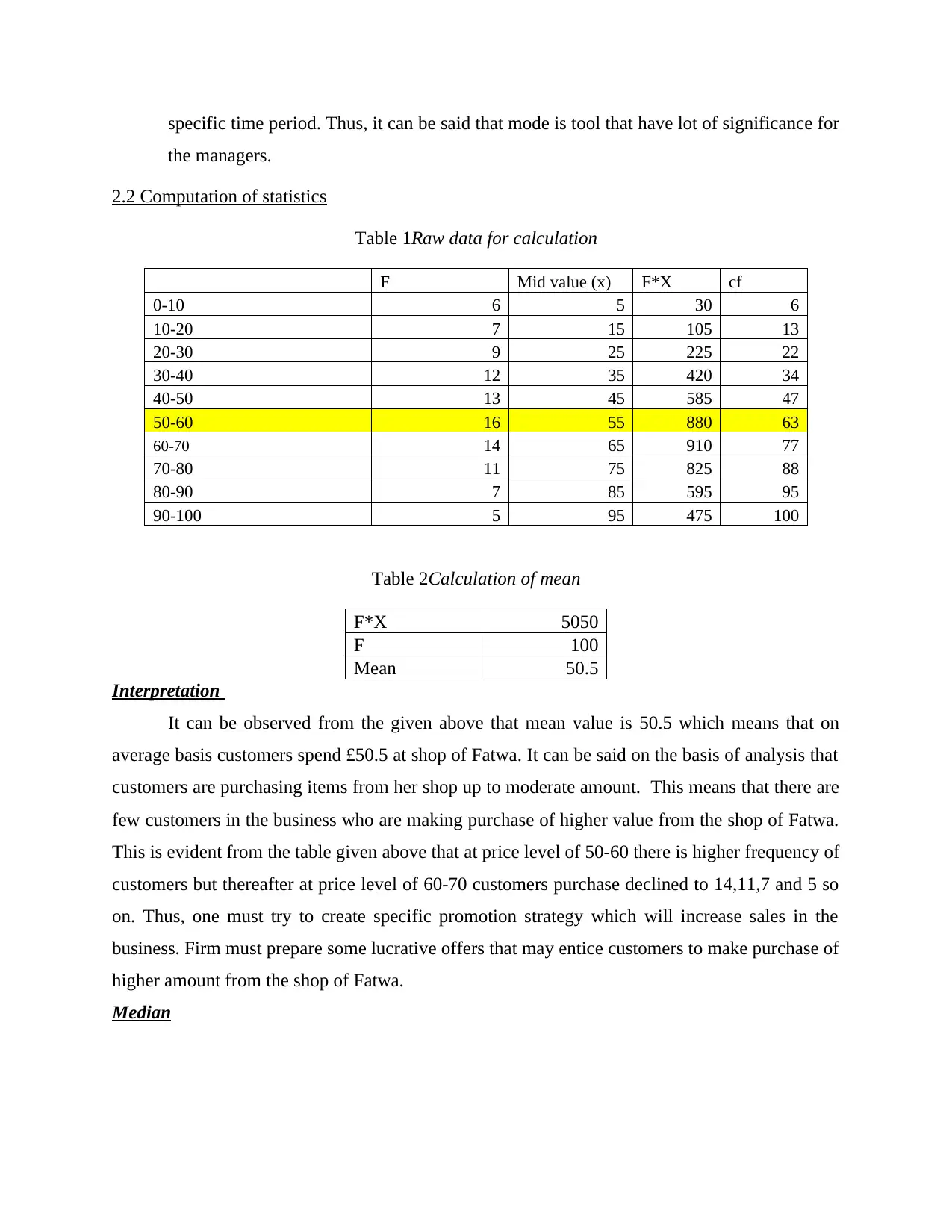
specific time period. Thus, it can be said that mode is tool that have lot of significance for
the managers.
2.2 Computation of statistics
Table 1Raw data for calculation
F Mid value (x) F*X cf
0-10 6 5 30 6
10-20 7 15 105 13
20-30 9 25 225 22
30-40 12 35 420 34
40-50 13 45 585 47
50-60 16 55 880 63
60-70 14 65 910 77
70-80 11 75 825 88
80-90 7 85 595 95
90-100 5 95 475 100
Table 2Calculation of mean
F*X 5050
F 100
Mean 50.5
Interpretation
It can be observed from the given above that mean value is 50.5 which means that on
average basis customers spend £50.5 at shop of Fatwa. It can be said on the basis of analysis that
customers are purchasing items from her shop up to moderate amount. This means that there are
few customers in the business who are making purchase of higher value from the shop of Fatwa.
This is evident from the table given above that at price level of 50-60 there is higher frequency of
customers but thereafter at price level of 60-70 customers purchase declined to 14,11,7 and 5 so
on. Thus, one must try to create specific promotion strategy which will increase sales in the
business. Firm must prepare some lucrative offers that may entice customers to make purchase of
higher amount from the shop of Fatwa.
Median
the managers.
2.2 Computation of statistics
Table 1Raw data for calculation
F Mid value (x) F*X cf
0-10 6 5 30 6
10-20 7 15 105 13
20-30 9 25 225 22
30-40 12 35 420 34
40-50 13 45 585 47
50-60 16 55 880 63
60-70 14 65 910 77
70-80 11 75 825 88
80-90 7 85 595 95
90-100 5 95 475 100
Table 2Calculation of mean
F*X 5050
F 100
Mean 50.5
Interpretation
It can be observed from the given above that mean value is 50.5 which means that on
average basis customers spend £50.5 at shop of Fatwa. It can be said on the basis of analysis that
customers are purchasing items from her shop up to moderate amount. This means that there are
few customers in the business who are making purchase of higher value from the shop of Fatwa.
This is evident from the table given above that at price level of 50-60 there is higher frequency of
customers but thereafter at price level of 60-70 customers purchase declined to 14,11,7 and 5 so
on. Thus, one must try to create specific promotion strategy which will increase sales in the
business. Firm must prepare some lucrative offers that may entice customers to make purchase of
higher amount from the shop of Fatwa.
Median
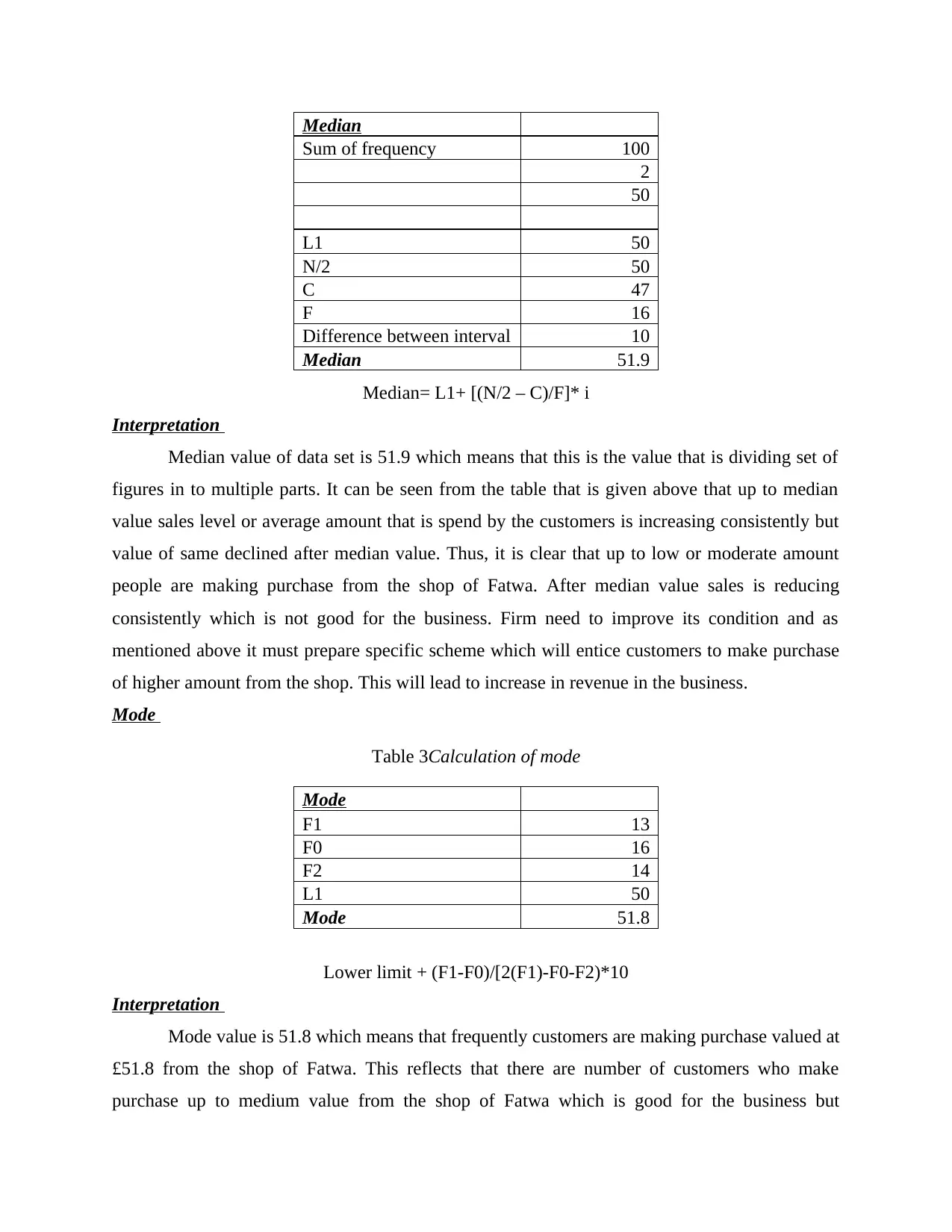
Median= L1+ [(N/2 – C)/F]* i
Interpretation
Median value of data set is 51.9 which means that this is the value that is dividing set of
figures in to multiple parts. It can be seen from the table that is given above that up to median
value sales level or average amount that is spend by the customers is increasing consistently but
value of same declined after median value. Thus, it is clear that up to low or moderate amount
people are making purchase from the shop of Fatwa. After median value sales is reducing
consistently which is not good for the business. Firm need to improve its condition and as
mentioned above it must prepare specific scheme which will entice customers to make purchase
of higher amount from the shop. This will lead to increase in revenue in the business.
Mode
Table 3Calculation of mode
Mode
F1 13
F0 16
F2 14
L1 50
Mode 51.8
Lower limit + (F1-F0)/[2(F1)-F0-F2)*10
Interpretation
Mode value is 51.8 which means that frequently customers are making purchase valued at
£51.8 from the shop of Fatwa. This reflects that there are number of customers who make
purchase up to medium value from the shop of Fatwa which is good for the business but
Median
Sum of frequency 100
2
50
L1 50
N/2 50
C 47
F 16
Difference between interval 10
Median 51.9
Interpretation
Median value of data set is 51.9 which means that this is the value that is dividing set of
figures in to multiple parts. It can be seen from the table that is given above that up to median
value sales level or average amount that is spend by the customers is increasing consistently but
value of same declined after median value. Thus, it is clear that up to low or moderate amount
people are making purchase from the shop of Fatwa. After median value sales is reducing
consistently which is not good for the business. Firm need to improve its condition and as
mentioned above it must prepare specific scheme which will entice customers to make purchase
of higher amount from the shop. This will lead to increase in revenue in the business.
Mode
Table 3Calculation of mode
Mode
F1 13
F0 16
F2 14
L1 50
Mode 51.8
Lower limit + (F1-F0)/[2(F1)-F0-F2)*10
Interpretation
Mode value is 51.8 which means that frequently customers are making purchase valued at
£51.8 from the shop of Fatwa. This reflects that there are number of customers who make
purchase up to medium value from the shop of Fatwa which is good for the business but
Median
Sum of frequency 100
2
50
L1 50
N/2 50
C 47
F 16
Difference between interval 10
Median 51.9
⊘ This is a preview!⊘
Do you want full access?
Subscribe today to unlock all pages.

Trusted by 1+ million students worldwide
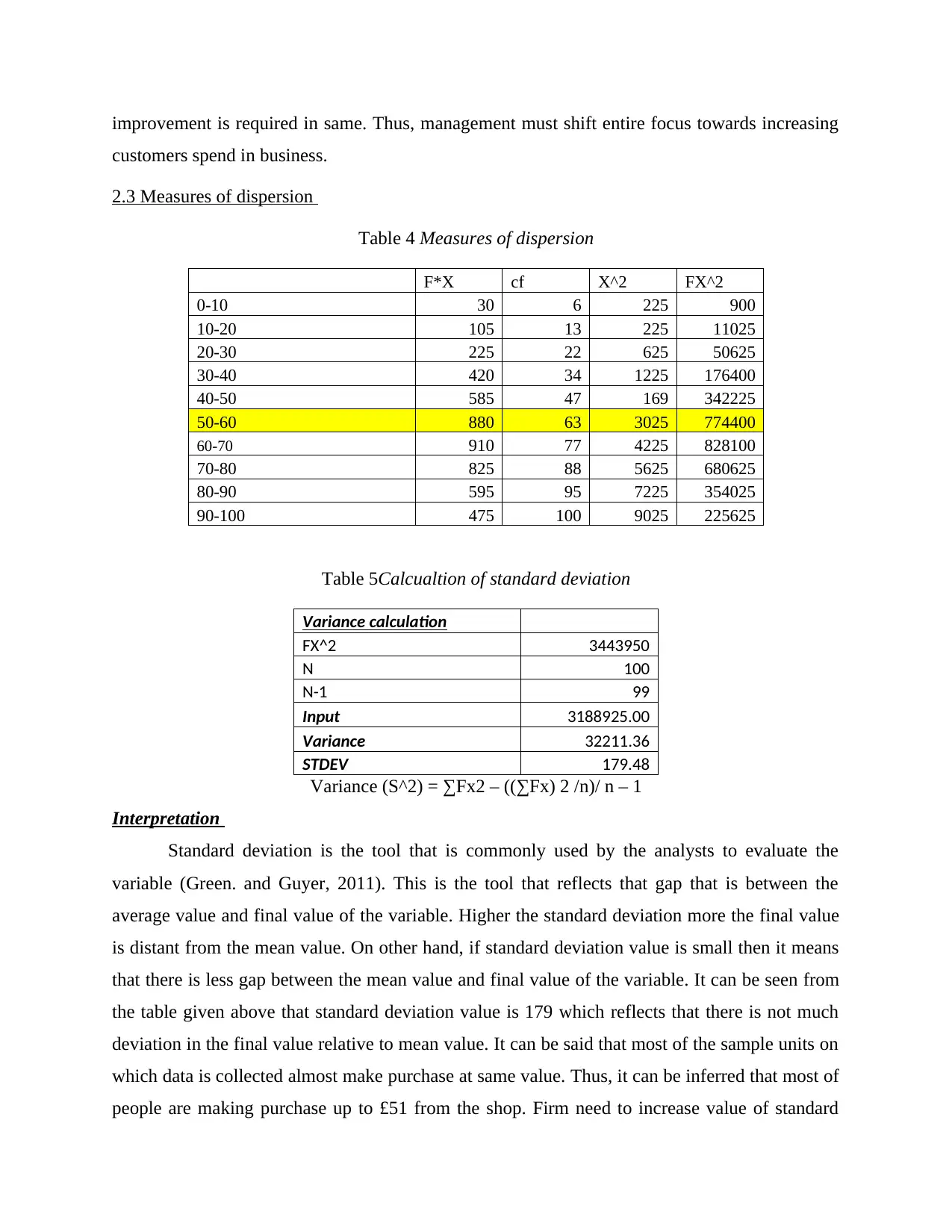
improvement is required in same. Thus, management must shift entire focus towards increasing
customers spend in business.
2.3 Measures of dispersion
Table 4 Measures of dispersion
F*X cf X^2 FX^2
0-10 30 6 225 900
10-20 105 13 225 11025
20-30 225 22 625 50625
30-40 420 34 1225 176400
40-50 585 47 169 342225
50-60 880 63 3025 774400
60-70 910 77 4225 828100
70-80 825 88 5625 680625
80-90 595 95 7225 354025
90-100 475 100 9025 225625
Table 5Calcualtion of standard deviation
Variance calculation
FX^2 3443950
N 100
N-1 99
Input 3188925.00
Variance 32211.36
STDEV 179.48
Variance (S^2) = ∑Fx2 – ((∑Fx) 2 /n)/ n – 1
Interpretation
Standard deviation is the tool that is commonly used by the analysts to evaluate the
variable (Green. and Guyer, 2011). This is the tool that reflects that gap that is between the
average value and final value of the variable. Higher the standard deviation more the final value
is distant from the mean value. On other hand, if standard deviation value is small then it means
that there is less gap between the mean value and final value of the variable. It can be seen from
the table given above that standard deviation value is 179 which reflects that there is not much
deviation in the final value relative to mean value. It can be said that most of the sample units on
which data is collected almost make purchase at same value. Thus, it can be inferred that most of
people are making purchase up to £51 from the shop. Firm need to increase value of standard
customers spend in business.
2.3 Measures of dispersion
Table 4 Measures of dispersion
F*X cf X^2 FX^2
0-10 30 6 225 900
10-20 105 13 225 11025
20-30 225 22 625 50625
30-40 420 34 1225 176400
40-50 585 47 169 342225
50-60 880 63 3025 774400
60-70 910 77 4225 828100
70-80 825 88 5625 680625
80-90 595 95 7225 354025
90-100 475 100 9025 225625
Table 5Calcualtion of standard deviation
Variance calculation
FX^2 3443950
N 100
N-1 99
Input 3188925.00
Variance 32211.36
STDEV 179.48
Variance (S^2) = ∑Fx2 – ((∑Fx) 2 /n)/ n – 1
Interpretation
Standard deviation is the tool that is commonly used by the analysts to evaluate the
variable (Green. and Guyer, 2011). This is the tool that reflects that gap that is between the
average value and final value of the variable. Higher the standard deviation more the final value
is distant from the mean value. On other hand, if standard deviation value is small then it means
that there is less gap between the mean value and final value of the variable. It can be seen from
the table given above that standard deviation value is 179 which reflects that there is not much
deviation in the final value relative to mean value. It can be said that most of the sample units on
which data is collected almost make purchase at same value. Thus, it can be inferred that most of
people are making purchase up to £51 from the shop. Firm need to increase value of standard
Paraphrase This Document
Need a fresh take? Get an instant paraphrase of this document with our AI Paraphraser
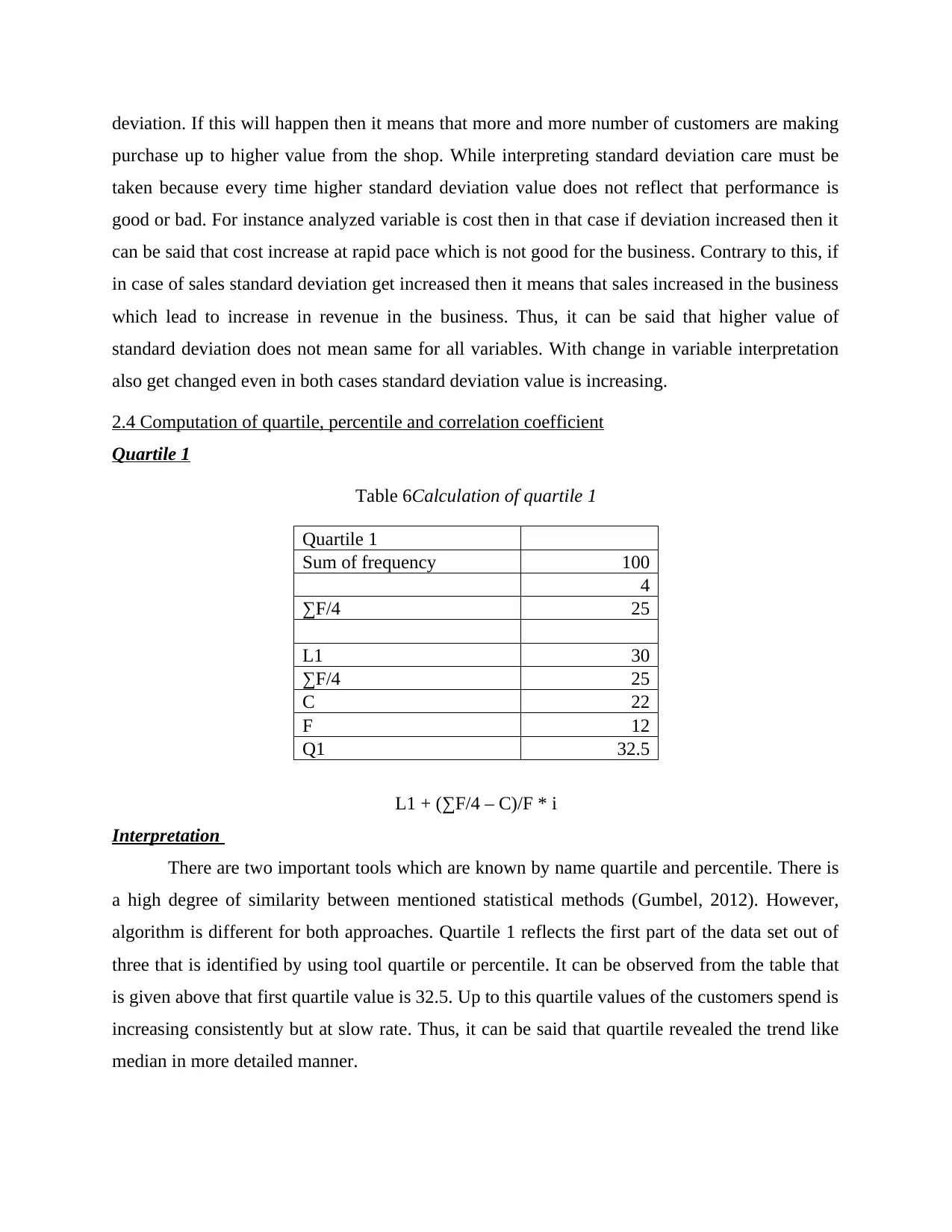
deviation. If this will happen then it means that more and more number of customers are making
purchase up to higher value from the shop. While interpreting standard deviation care must be
taken because every time higher standard deviation value does not reflect that performance is
good or bad. For instance analyzed variable is cost then in that case if deviation increased then it
can be said that cost increase at rapid pace which is not good for the business. Contrary to this, if
in case of sales standard deviation get increased then it means that sales increased in the business
which lead to increase in revenue in the business. Thus, it can be said that higher value of
standard deviation does not mean same for all variables. With change in variable interpretation
also get changed even in both cases standard deviation value is increasing.
2.4 Computation of quartile, percentile and correlation coefficient
Quartile 1
Table 6Calculation of quartile 1
Quartile 1
Sum of frequency 100
4
∑F/4 25
L1 30
∑F/4 25
C 22
F 12
Q1 32.5
L1 + (∑F/4 – C)/F * i
Interpretation
There are two important tools which are known by name quartile and percentile. There is
a high degree of similarity between mentioned statistical methods (Gumbel, 2012). However,
algorithm is different for both approaches. Quartile 1 reflects the first part of the data set out of
three that is identified by using tool quartile or percentile. It can be observed from the table that
is given above that first quartile value is 32.5. Up to this quartile values of the customers spend is
increasing consistently but at slow rate. Thus, it can be said that quartile revealed the trend like
median in more detailed manner.
purchase up to higher value from the shop. While interpreting standard deviation care must be
taken because every time higher standard deviation value does not reflect that performance is
good or bad. For instance analyzed variable is cost then in that case if deviation increased then it
can be said that cost increase at rapid pace which is not good for the business. Contrary to this, if
in case of sales standard deviation get increased then it means that sales increased in the business
which lead to increase in revenue in the business. Thus, it can be said that higher value of
standard deviation does not mean same for all variables. With change in variable interpretation
also get changed even in both cases standard deviation value is increasing.
2.4 Computation of quartile, percentile and correlation coefficient
Quartile 1
Table 6Calculation of quartile 1
Quartile 1
Sum of frequency 100
4
∑F/4 25
L1 30
∑F/4 25
C 22
F 12
Q1 32.5
L1 + (∑F/4 – C)/F * i
Interpretation
There are two important tools which are known by name quartile and percentile. There is
a high degree of similarity between mentioned statistical methods (Gumbel, 2012). However,
algorithm is different for both approaches. Quartile 1 reflects the first part of the data set out of
three that is identified by using tool quartile or percentile. It can be observed from the table that
is given above that first quartile value is 32.5. Up to this quartile values of the customers spend is
increasing consistently but at slow rate. Thus, it can be said that quartile revealed the trend like
median in more detailed manner.

Table 7Quartile 3
Quartile 3
3 3
∑F/4 25
3*∑F/4 75
L1 60
3*∑F/4 75
C 63
F 14
I 10
C/F 4.5
Q3 68.57142857
L1+ [3(∑F/4)-C/F]* i
Interpretation
Third quartile revealed the third part of the data set. It can be seen from the table given
above that value of third quartile is 68.57. It can be seen from the table that up to this value
almost value of customers spend increased but after this value customers spending get reduced.
Thus, it can be said that at higher price level firm needs to improve its performance.
Inter quartile range
Inter quartile range reflects the difference that exists between the higher and lower value
of the variable (Kazdin, 2011). It can be seen from the table that value of Q3 is 68.57 and same
of Q1 is 32.5 which means value of inter quartile range is 36.07. It can be said that there is little
or moderate difference between both quartile values.
Correlation coefficient
Table 8 Calculation of correlation
Year Sales Cost Profit
2004 160 110 50
2005 170 110 60
2006 210 130 80
2007 220 120 100
2008 300 115 185
2009 280 150 130
Quartile 3
3 3
∑F/4 25
3*∑F/4 75
L1 60
3*∑F/4 75
C 63
F 14
I 10
C/F 4.5
Q3 68.57142857
L1+ [3(∑F/4)-C/F]* i
Interpretation
Third quartile revealed the third part of the data set. It can be seen from the table given
above that value of third quartile is 68.57. It can be seen from the table that up to this value
almost value of customers spend increased but after this value customers spending get reduced.
Thus, it can be said that at higher price level firm needs to improve its performance.
Inter quartile range
Inter quartile range reflects the difference that exists between the higher and lower value
of the variable (Kazdin, 2011). It can be seen from the table that value of Q3 is 68.57 and same
of Q1 is 32.5 which means value of inter quartile range is 36.07. It can be said that there is little
or moderate difference between both quartile values.
Correlation coefficient
Table 8 Calculation of correlation
Year Sales Cost Profit
2004 160 110 50
2005 170 110 60
2006 210 130 80
2007 220 120 100
2008 300 115 185
2009 280 150 130
⊘ This is a preview!⊘
Do you want full access?
Subscribe today to unlock all pages.

Trusted by 1+ million students worldwide
1 out of 22
Related Documents
Your All-in-One AI-Powered Toolkit for Academic Success.
+13062052269
info@desklib.com
Available 24*7 on WhatsApp / Email
![[object Object]](/_next/static/media/star-bottom.7253800d.svg)
Unlock your academic potential
Copyright © 2020–2025 A2Z Services. All Rights Reserved. Developed and managed by ZUCOL.





